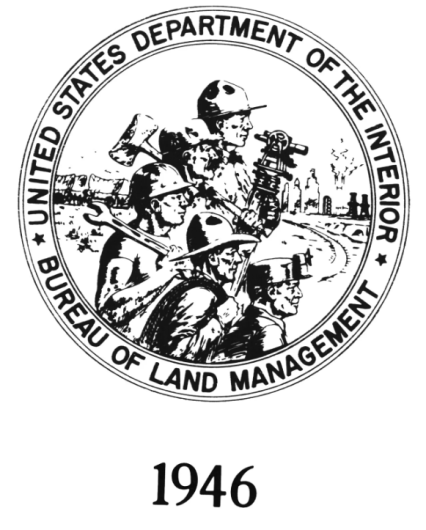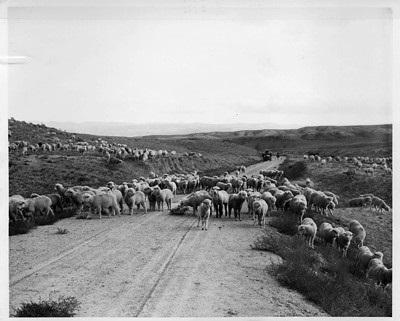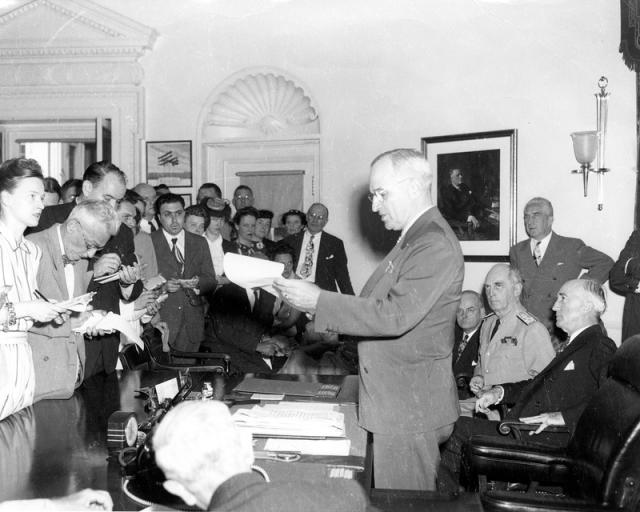You are viewing ARCHIVED content published online before January 20, 2025. Please note that this content is NOT UPDATED, and links may not work. Additionally, any previously issued diversity, equity, inclusion or gender-related guidance on this webpage should be considered rescinded. For current information, visit https://www.blm.gov/blog.
The beginning of BLM: How 486 words created the nation’s largest land manager
Today is an important one in the history of the Bureau of Land Management (BLM). On May 16, 1946—78 years ago—the agency was conceived on paper, when President Harry S. Truman submitted to Congress “Reorganization Plan 3.” The plan included the proposal to merge the General Land Office and the U.S. Grazing Service to create one agency. Fast forward 78 years and our day-to-day activities are quite busy addressing proposals to construct renewable energy projects, improving recreation sites, responding to wildfires, and conducting all of the other work required to care for 245 million surface acres. That’s about one in every ten acres of the United States, not to mention the 30 percent of the Nation’s minerals we manage on behalf of the American people.

When President Truman issued this simple reorganization plan, it consisted of only 486 words regarding the proposed merger. That merger took effect three months later—on July 16, 1946—and set in motion the process to create an agency that today manages more public land than any other federal government agency in the U.S. This action dissolved the General Land Office, which got its start more than 130 years earlier, in 1812. It also dissolved the U.S. Grazing Service, which had existed for just 12 years, since 1934.
Here is what President Truman said in his “Special Message to the Congress Transmitting Reorganization Plan 3 of 1946,” explaining the rationale for merging the two agencies:
The General Land Office and the Grazing Service now divide responsibility for major portion of the multiple-use Federally owned lands now held by the Department of the Interior. The lands under jurisdiction of the two agencies are comparable in character and in use. In some functions, the two agencies employ the same type of personnel and use the same techniques. Other functions are divided between the agencies so that both are engaged in management of various aspects of the same land. Consolidating these two agencies will permit the development of uniform policies and the integration of two organizations whose responsibilities now overlap. Integration of the activities of the two agencies will make possible greater utilization and thus more economic use of expert skills.
In other words, the primary purpose of merging the agencies to form the BLM was to increase efficiency. The same can be said for the reorganizations of several other federal Departments and agencies included in Reorganization Plan 3 of 1946.[1]

The Special Message leaves a couple of impressions on this writer.
First, the fact that reorganizing the Federal government was on President Truman’s radar in 1946 at all seems astonishing, given domestic and international events. At the time the Special Message was transmitted, he had only been President for about one year. Truman became President, after serving for just 82 days as vice president, when President Roosevelt died in office in April 1945. World War II officially ended just eight months earlier, when Japan surrendered in September 1945. Americans were still reeling from the loss of more than 400,000 U.S. civilians and soldiers during the war and facing the reality of the “iron curtain” in Eastern Europe and the beginning of the Cold War.

Second, after experiencing several agency reorganizations, the fact that the merger took effect just two months after Reorganization Plan 3 was transmitted to Congress feels like lightning speed! However, as outlined in “Opportunity and Challenge,”[2] while establishing the BLM may have been relatively quick and easy, for the next two years the agency struggled to simply survive, due to difficulties of implementing an organizational structure and securing adequate funding.
Finally, the BLM was born of the modest goal of increasing efficiency. Never in their wildest dreams could the developers of Reorganization Plan 3 have imagined that the agency would become what is today – a steward of some of the most spectacular places on the planet, a manager of a dizzying array of natural and cultural resources, and an organization that many public land stakeholders rely upon for commercial opportunities, conservation of wild landscapes, and outdoor recreation experiences. That is worthy of reflection, and celebration, 78 years after the transmittal of Reorganization Plan 3!

Footnotes:
[1] Reorganization Plan 3 also transferred jurisdiction over mineral deposits on lands held by the Department of Agriculture to the Department of the Interior.
[2] Opportunity and Challenge, The Story of BLM. pp. 54-57.
Jennifer Jones, Experienced Services Program
Related Stories
- Protecting Lands and Communities: Shaila Pomaikai Catan
- Celebrating the power of public lands through tourism and community impact
- Top 5 things to know about the Comprehensive Animal Welfare Program
- First 100 days: BLM drives energy expansion and national strength
- BLM Recreation Sites Available to All: Exploring Accessibility on Colorado’s Public Lands
Office
1849 C Street NW
Washington, DC 20240
United States
